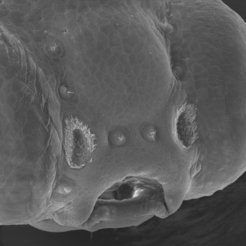The mechanical switch in the ear
Max Planck scientists have discovered the elusive channel that converts mechanical energy into electrical signals in sensory hair cells
Mechanical stimuli such as sound and movement are perceived by the specialized receptors of the inner ear. These mechanical receptors are called sensory hair cells because of a tuft of hairs or specialized processes present at the top of the cell. When sound or movement causes the hairs to shear or deflect, ions flow into the cells, thereby transducing the mechanical energy into electrical energy. Unlike the other senses of vision, olfaction, and touch sensation, the molecular basis of transduction in sensory hair cells was unknown until now. Biophysical experiments with sensory hair cells have proven that transduction channels mediate the conversion, however, the identity of these channels has remained elusive for the past two decades. In a new report in the international journal Science (Science Express, June 12, 2003), researchers at the Max Planck Institute for Developmental Biology (Tübingen) and for Medical Research (Heidelberg) have identified a candidate for this long sought channel in zebrafish.
Our senses allow us to keep tract of the physical world. The specialized receptors in our eyes, skin and tongue enable us to perceive light, to sense touch, and to feel whether something is painful or cold. All of these senses depend on the conversion of the stimulus into an electrical signal that is sent to the brain. Interestingly, many of these sensory receptors use the same type of ionic channel (transient receptor potential channels or TRP channels) to mediate this conversion or transduction of the signal. Channels are membrane proteins that form pores allowing small molecules to flow into the cell. How these channels are gated or switched on depends on the stimulus.
Genetic studies in various organisms like worms and fruit flies have been very successful in identifying the molecules involved in the senses. In fact, a major breakthrough for the molecular basis of mechanosensation was made when Walker and colleagues identified a novel TRP channel required for fruit fly touch sensation [R. Walker, A. Willingham, C. Zucker, Science 287, 2229 (2000)]. However, a homologue in higher animals or vertebrates was not found in any genomic databases, that is, this particular channel, NompC, appeared to be specific to invertebrates such as worms and flies.

The hope that NompC might mediate sensory hair cell transduction faded until recently, when Sidi and colleagues at the Max Planck Institute for Developmental Biology in Tübingen and Medical Research in Heidelberg identified a vertebrate homologue of NompC in zebrafish. Eliminating the presence of the normal channel and thus its activity caused deafness in zebrafish larvae (3-4 days old). Electrical recordings from zebrafish sensory hair cells demonstrated that NompC is required for transduction of a mechanical stimulus. Thus, NompC is used both by lower animals such as fruit flies and vertebrates such as fish for sensing mechanical stimuli. It is very likely that this particular sensory system evolved in an ancestor common to both arthropds and chordates.
